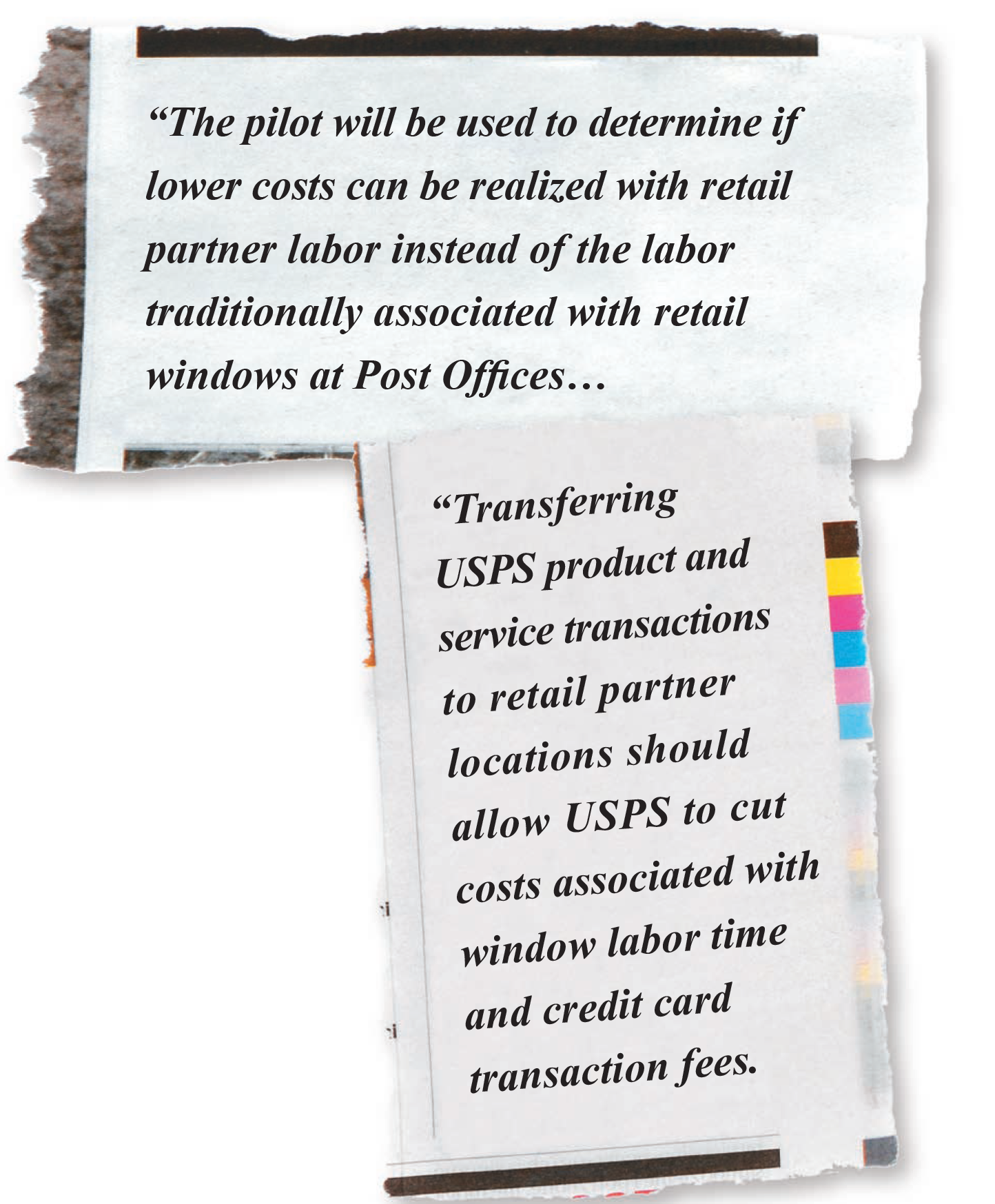April 24, 2014
Stop Staples – In Depth
What Are Staples and USPS Trying to Hide? Plenty.
 The U.S. Postal Service and Staples are working overtime to keep the details of their sweetheart deal a secret, but an April 1 hearing before the National Labor Relations Board – and documents the USPS was forced to turn over to the American Postal Workers Union – have revealed some very troubling facts. (See ‘Customers: Think Twice’ and ‘Is the Staples Deal Postal Privatization?’)
The U.S. Postal Service and Staples are working overtime to keep the details of their sweetheart deal a secret, but an April 1 hearing before the National Labor Relations Board – and documents the USPS was forced to turn over to the American Postal Workers Union – have revealed some very troubling facts. (See ‘Customers: Think Twice’ and ‘Is the Staples Deal Postal Privatization?’)
But the document hides more than it illuminates. Most of the significant details in the Approved Postal Provider Pilot Agreement are redacted. “The Postal Service belongs to the people of the country,” Dimondstein said. “What are they hiding? And how can they justify operating in the dark?”
Customers: Think Twice
“Staples and USPS management are perpetrating a fraud on the people of this country,” says APWU President Mark Dimondstein. “They are promoting the deal as though taking your mail to Staples is the same as taking it to the Post Office.
“It’s not.”
The 58-page agreement outlining the deal between the USPS and Staples should make customers think twice before turning over their mail to Staples. A heavily redacted version of the agreement between the USPS and Staples and testimony at an April 1, 2014, NLRB hearing reveal the following:
Packages dropped off at Staples stores will be placed in unsecured containers.
- Packages and letters at Staples stores are not considered “mail” until they are picked up by the Postal Service. That means they don’t enjoy the protection of the U.S. Mail.
- Staples is getting a discount on postal products, but customers will pay full price. (The amount of the discount is redacted.)
- Staples’ low-paid, high-turnover employees get just four hours of “classroom” training for postal retail duties.
“The APWU favors expanding service,” Dimondstein said. “But postal services must be provided by highly-trained uniformed employees of the U.S. Postal Service – weather it’s at the Post Office or Staples.”
- Postal retail clerks receive 32 hours of intense classroom training, followed by 40 hours of on-the-job training alongside experienced window clerks. USPS employees learn all the intricacies necessary to provide expert customer service: the postage needed for various classes of mail and for mail of various sizes and shapes; how quickly letters and packages can be expected to arrive at their destination; how to screen for hazardous material that shouldn’t be mailed, etc.
- Postal workers must pass a test before they are considered qualified to work the window.
- Before they are hired, USPS employees undergo a background check; take an oath to protect the security and safety of the mail, and are bound by a Code of Ethical Conduct.
- USPS employees answer to the American people.
Is the Staples Deal Postal Privatization?
Postmaster General ‘Completely Dishonest,’ Union Charges
 An April 1 hearing before the National Labor Relations Board revealed how “completely dishonest” Postmaster General Patrick Donahoe has been about the purpose of the Postal Service’s deal with Staples, APWU President Mark Dimondstein said after the proceeding.
An April 1 hearing before the National Labor Relations Board revealed how “completely dishonest” Postmaster General Patrick Donahoe has been about the purpose of the Postal Service’s deal with Staples, APWU President Mark Dimondstein said after the proceeding.
The Postmaster General has repeatedly rejected union charges that opening “postal” counters in Staples stores and staffing them with low-wage Staples employees constitutes privatization. In a Jan. 19 Associated Press article, Donahoe is quoted as saying, “The privatization discussion is a ruse. We have no interest in privatizing the Postal Service.”
But a 2012 internal USPS document that was presented at the NLRB hearing shows that management is indeed seeking to privatize window clerk duties – to replace living-wage U.S. Postal Service jobs with low-wage, high-turnover, non-union Staples jobs.
The Postal Service’s Approved Shipper Plus Pilot Program Memo makes it clear:
“The Staples deal is designed to avoid USPS labor costs by transferring window duties to private businesses. That’s privatization,” said APWU President Mark Dimondstein.
Just the Beginning
The Staples “pilot program” is just the beginning. The Jan. 19 Associated Press article also quotes Donahoe as saying he’d like to see post office counters in every Staples store “as soon as possible.”
And it’s not just Staples. The Approved Shipper program “aims to establish USPS customer access points in leading national and regional retailer’s store locations nationwide.”
“We intend to make sure the American people understand how serious the threat is – to the United States Postal Service as a public institution and to living-wage jobs,” Dimondstein said.
“The Staples deal is designed to avoid USPS labor costs by transferring window duties to private businesses. That’s privatization,” said APWU President Mark Dimondstein.
Following a Pattern
At the NLRB hearing, USPS witness Brian Code testifi ed that USPS executives studied postal retail trends in Germany, Great Britain, Sweden, Australia, Canada and other countries, and used them as models for the program.
What do those countries’ mail systems have in common?
Their retail operations are largely privatized. As of 2011, according to a report by the Government Accountability Office (GAO), Germany’s postal retail operations were 98% privately owned and operated; Sweden’s were 88% private, and Australia’s were 81% private. Great Britain’s Royal Mail, which is mostly privatized, was not included in the study.
Not Necessarily a Single Event
Regrettably, many in the media take the Postmaster General at his word. That’s because they accept the faulty premise that postal privatization would have to occur as a single event – most likely precipitated by an act of Congress.
But that’s not necessarily the case. The postal systems cited above were privatized gradually. And the USPS has already transferred large chunks of its operations to private businesses. There are currently 65,000 “retail alternatives” to the Postal Service, including personal computers, stamps-only sales at grocery stores and other outlets.
What makes the Staples deal so signifi cant is the scale. Staples is a national chain with more than 1,500 stores. And the Staples postal units are not just selling stamps – they’re performing many of the functions USPS retail clerks perform.
Does It Matter?
Does it matter if the U.S. Postal Service privatizes its retail operations? You bet it does.
As an independent agency of the federal government, the Postal Service is accountable to the American people. Under federal law, the USPS has a “universal service obligation.” The Postal Reorganization Act says, “The Postal Service shall have as its basic function the obligation to provide postal services to bind the Nation together… It shall provide prompt, reliable, and efficient services to patrons in all areas and shall render postal services to all communities.”
The USPS can’t walk away from unprofi table neighborhoods. Before the USPS can make significant changes to service, it must notify the citizenry and allow the people to offer input.
Staples has no such responsibility. Staples has one obligation: to make a buck for shareholders. In March, Staples announced plans to close 225 stores. No notice. No input.
What if those stores had replaced the post offi ces in those neighborhoods? Who would serve the residents once Staples closed?
Doesn’t USPS financial crisis make the Staples deal – and others like it – inevitable? Actually, no.
 Despite headlines that announce the USPS has lost billions of dollars, the Postal Service isn’t broke. To be more precise, it isn’t losing money collecting, sorting and delivering mail. And the Internet isn’t destroying the world’s largest postal system. First-class mail volume has declined, but ecommerce is causing an explosion in package volume.
Despite headlines that announce the USPS has lost billions of dollars, the Postal Service isn’t broke. To be more precise, it isn’t losing money collecting, sorting and delivering mail. And the Internet isn’t destroying the world’s largest postal system. First-class mail volume has declined, but ecommerce is causing an explosion in package volume.
In fact, the Postal Service’s “financial crisis” has very little to do with mail.
The USPS financial crisis is a manufactured one. It was caused by Congress, and Congress can fix it – without using a dime of taxpayer money. (The Postal Service hasn’t been supported by taxpayers in more than 30 years. All its revenue is generated by the sale of its products and services.)
The fundamental cause of the USPS crisis is a provision in the 2006 Postal Accountability and Enhancement Act (PAEA), which requires the Postal Service to pre-fund future retiree healthcare costs in a way no other public or private entity does: The USPS must prepay retiree health benefi ts 75 years in advance over a 10-year period – at a cost of approximately $5.5 billion per year. The USPS has already set aside approximately $50 billion for these benefits.
The Postal Service had an operating surplus of $600 million in fiscal year 2013. The Postal Service’s “losses” for the year were the result of the pre-funding requirement.
And the trend continues. During the first quarter of Fiscal Year 2014 the USPS enjoyed an operating surplus of $765 million. But the agency’s good news was buried in most media accounts, which said the USPS suffered a loss of $354 million loss. The USPS reported losses for the first quarter of 2014 for one reason – the congressional mandate that requires the Postal Service to pre-fund healthcare benefits for future retirees.


